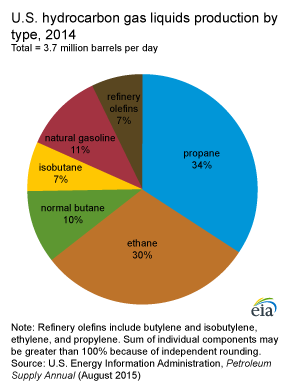Hydrocarbon gas liquids are derived from natural gas and crude oil
Hydrocarbon gas liquids (HGL) are produced when raw natural gas is processed at natural gas processing plants and when crude oil is refined into petroleum products. Most of the HGL produced in the United States are separated from natural gas at natural gas processing plants.
Hydrocarbon gas liquids from natural gas processing
HGL are present as gases in deposits of natural gas. Raw, or untreated, natural gas produced from natural gas wells and oil wells is called wet gas because it sometimes contains HGL, along with water vapor and other nonhydrocarbon gases. HGL should not be confused with lease condensate separated out of associated and nonassociated natural gas at lease facilities. The liquid condensate is usually added to crude oil in pipelines that transport oil to refineries.
Natural gas is usually treated at natural gas processing plants before it enters natural gas transmission pipelines. HGL extracted from natural gas as liquids at these plants are called natural gas plant liquids (NGPL). Natural gas that has been processed to remove most of the HGL and nonhydrocarbon compounds is called dry gas, which consists of mostly methane. Natural gas pipeline operators have strict specifications for the characteristics (such as the heat content) of the dry natural gas that they accept, which in turn limits the amount of HGL contained in natural gas that is transported through these pipelines.
Mixed HGL streams (also known as Y-grade) are separated from each other by the process of fractionation. Fractionation facilities may be co-located at natural gas processing plants, or they may receive mixed HGL streams from several processing plants. Fractionation facilities separate some or all the individual HGL that are then sold as purity products—ethane, propane, normal butane, and isobutane product streams consisting of a minimum of 90% of one type of HGL molecule.
Most of the natural gas processing and fractionation plants in the United States are located in areas where natural gas and crude oil production is concentrated. In 2014, HGL from natural gas processing accounted for about 82% of total U.S. natural gas plant and refinery HGL production.
Hydrocarbon gas liquids from crude oil refining
Propane and propylene are the HGL streams that are produced and sold as separate purity products in the largest volumes by petroleum refiners. Most of the other volumes of HGL produced at refineries are burned as fuels or are used to make gasoline and petrochemical feedstock.










